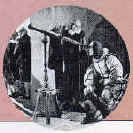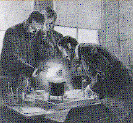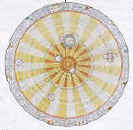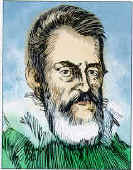Science: Groping in the Dark – Part 2
| 1360 |
|
 |
|
| 1670 |
|
 Steam locomotive |
| 1830 |
|
 J.J. Thompson |
|
 Marie & Pierre Curie |
| 1900 |
|
| 2000 |
Through a Glass Darkly
 |
| Nicolaus Copernicus (1473-1543) |
 |
| Sun-centered theory of the universe |
 |
| Galileo Galilei (1564-1642) |
No amount of fear and repression can forever stop people from thinking. After many years of meticulous calculation, Nicolaus Copernicus (1473-1543) rejected the cosmology of Aristotle and Ptolemy and showed that the earth was a planet revolving around the sun. But he was a prudent man, not letting his work be published until just before his death.
Galileo Galilei (1564-1642) used the newly invented telescope to confirm the findings of Copernicus. He begged the church authorities to consider changing the official views. How could honest people be asked to believe what was demonstrably untrue?
Some theologians may have agreed with Galileo, but the traditional view prevailed. Mathematical tricks and fuzzy images in primitive telescopes had nothing to do with the truth. It was an insult to God. It was sorcery and an unpardonable invasion of the heavenly domain. Copernicus’ works were labeled as heresy and banned. Galileo was ordered to recant, then he was imprisoned for the rest of his life.
Besides, at this time, the established church was having enough trouble with the Protestant reformers. This was no time for mischievous scientists to make a nuisance of themselves. (Not that the Protestant reformers were any more enlightened. Martin Luther called Copernicus a fool intent on reversing the whole science of astronomy.)
It is important to understand that men like Copernicus and Galileo were not questioning the authority of the Bible. They maintained a deep respect for the Scriptures, believing that scientific observation was a confirmation of revealed truth. But the church authorities remained adamant in their opposition to experimental science.
Men of genius like Leonardo da Vinci (1452-1519) and Michelangelo (1475-1564) were continuing to experiment in less controversial areas, such as engineering, art and architecture. They were ahead of their time, but their flashes of brilliance could not hide the fact that there still did not exist a systematic understanding of scientific principles. Knowledge was fragmented and disorganized, like a book without a table of contents, chapter headings or an index.
Someone was needed to tie the fragments of information into an overall framework of understanding.
The Breakthrough
 |
| Isaac Newton (1641-1727)Newton’s Principia Mathematica,published in 1687, is considered one of the greatest scientific books ever written. In it, Newton explained his laws of motion and theory of universal gravitation. |
 |
That person was Sir Isaac Newton (1642-1727), one of the world’s greatest scientific geniuses. He is best known for formulating the theory of gravity. Newton, of course, was not the first person to notice gravity. The story of the apple falling on his head as he sat under a tree is probably a legend. But he is credited with being the first to recognize that the various effects of nature are governed by universal laws. The force that made an apple fall was the same force that governed the motion of the earth around the sun.
In 1687, Newton published his remarkable book Philosophiae Naturalis Principia Mathematica, showing how the previously unfathomable secrets of nature could be expressed in formulas and equations. Newton showed that although the creation looks complicated, its basic workings are quite simple. It is like a watch, which at first glance seems like a jumble of springs, sprockets and gears, but on closer examination is seen to operate on basic mechanical principles. Newton discovered a far-reaching principle: Laws govern physical phenomena.
Newton’s laws of mechanics, gravitation and motion, along with the invention of calculus, gave scientists tools to understand the world and even the universe as never before. The creation was seen to behave like a giant clock that, having been wound up, ticked steadily and predictably along.
Newton was aware that his methods only explained how the universe worked — not why. It is interesting to note that he maintained a deep interest in theology and spent his last years in a study of biblical prophecy. But ironically, his theories and laws opened even wider the gap developing between religion and science. The more natural phenomena could be explained, the more the grip of superstition and dogma loosened.
The medieval concept of God in heaven, and puny humans here below, continued to change. Now people began to see that they could become the revelator of nature’s secrets.
The scientists now had their hands on the home keys. They could learn from the mistakes of the past and apply the new scientific techniques to explore and experiment in ways never possible before. The forces that made the world work had become definable, and what is even more important, they began to be harnessed. It was the breakthrough needed, and the pace of invention quickened.
In 1851, Britain, the first industrial nation, staged the Great Exhibition in London’s Hyde Park. The centerpiece was the Crystal Palace, a monumental structure of iron and glass, a suitable temple to humanity’s newfound industrial genius. Beneath its soaring roof, the wonderful inventions of the industrial nations were arrayed for the world to admire.
Eight years later, Charles Darwin published The Origin of Species, in which he explained his theories of the evolution of life. At first even Darwin was reluctant to suggest the possibility of such a complex creation as life without a Creator. But his theory led him to an inevitable conclusion: Humans were not a unique creation. They were rather the most capable, efficient and intelligent creatures to have evolved through the process of natural selection. The human race was the magnificent end product of millions of years of evolution. As Darwin-ism put it, only the fittest survived.
For a people becoming infatuated with their own ingenuity, this was the right idea at the right time. The Western world was transforming itself into an industrial society, ready to exploit the earth’s resources as never before. Competition, it was claimed, was the first law of nature, and humans had won. Might was right, and thus humans had the right to dominate the planet.
So dominate they did.
The Triumph of Technology
Marvelous inventions began to transform the way the world lived. No longer did it amble along to the rhythm of nature. A network of canals, roads and railroads joined the new industrial cities. Steam was harnessed and obediently pushed the pistons that drove mighty locomotives at unprecedented speeds, or propelled great ships across the oceans, independent of wind and tide.
The invention of the internal combustion engine made possible the automobile, and with it a new freedom of movement.
Thomas Edison’s persistent experiments with electric light turned night into day. Messages sped along telegraph wires strung across the continents and through cables under the ocean. What used to take days or even months could now be accomplished in seconds.
In 1894, Marchese Guglielmo Marconi built his first radio equipment, and even the airwaves began dancing to the new tune.
What a world it was — with great machines clanking and puffing, their boilers hissing, motors whirring, wires humming and sparks flying — all obedient to predictable, definable laws, and all under human control.
Even the depths of the universe became humanity’s territory. Using Newton’s laws, scientists predicted, plotted and found previously unknown planets on the fringes of the solar system.
And at the other end of creation, the smallest pieces of matter were giving up their secrets. Physicists had long accepted that matter was made up of indivisible particles called atoms. Now they began to pry them open, discovering electrons and the protons and neutrons that made up the nuclei.
About a hundred years ago a young German student, Max Planck, asked his teacher for some advice on his future career. He had two options. He could become a physicist, or he could study to be a concert pianist. Be a pianist, he was advised. “Physics is finished. . . . It’s a dead-end street.” But young Max Planck chose to walk down the “dead-end street” and helped turn the world of science upside down.
